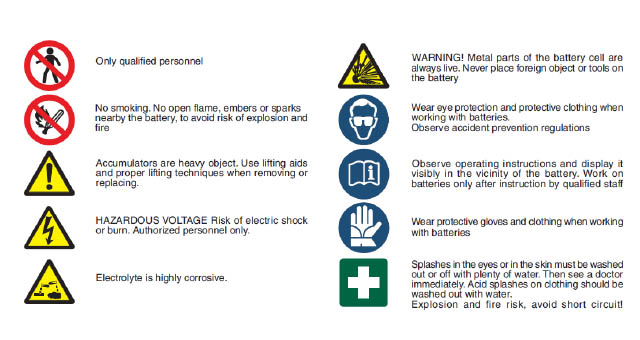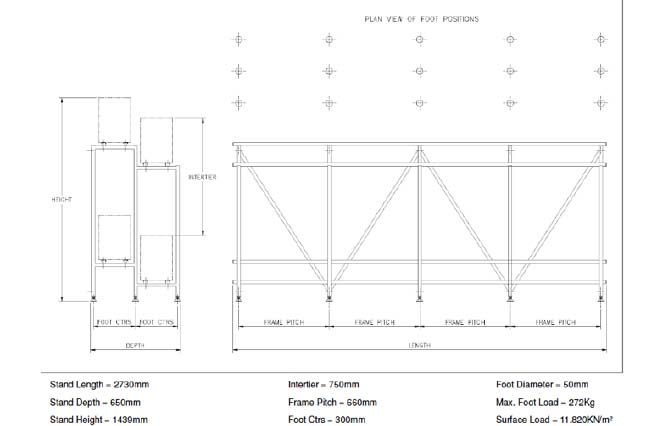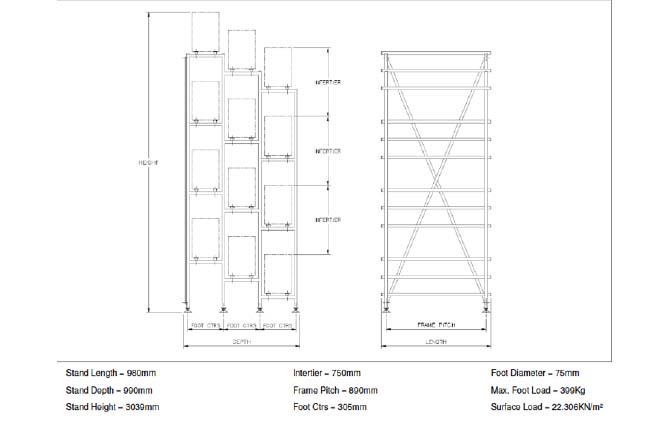Considerations For Battery Room Design, Battery Stands and Enclosures.
This article looks at the preferred designs for battery rooms and discusses how batteries should be laid out to give a safe environment. Alternative battery stand types are discussed to illustrate accessibility of the cells or monoblocs and safety considerations.
VRLA, Vented and Nickel Cadmium battery types are included.
Fully detailed information can be found in International Standards such as BS EN
50272-2:2001. This article gives an overview only to the more important subjects.
OVERVIEW
Battery rooms can be a hazardous place and all persons entering must be aware of the dangers. All too often, inexperienced people enter a room without receiving any safety information. Visitors who may have never been in a battery room previously are particularly vulnerable and must be give a short overview of the hazards. Topics discussed should include emergency evacuation procedure although this may be covered immediately after entering the room when emergency exit routs can be pointed out. High voltage and the need not to touch any part of the battery or stand should be explained. Battery acid and lead compounds and the risk of explosion due to the build up of explosive gasses should be discussed. The hazards with nickel cadmium batteries, which contain highly corrosive potassium hydroxide and give off hydrogen, should be discussed.
No persons should be allowed to enter a battery room without the correct clothing. Man made synthetic clothing may generate a static charge which can result in a spark which in turn may ignite the explosive gasses given off by all lead-acid and nickel cadmium battery types. This is less critical when considering VRLA batteries. For people not actually working on the battery or touching it, such as visitors, every day clothing is acceptable.
The owner of the battery has a duty of care towards all persons entering a battery room.
A fully documented Method Statement and Risk Assessment must be covered for any person working on any part of a battery system. Even visitors may be required to sign the documents to confirm they have understood them and will comply with a simple Method Statement, even if they are not directly involved in the work. Lone working is possible when working in a battery room providing the activity is clearly understood and emergency procedures are in place.
As a final overview, all doors to the battery room must be anti-panic and open outwards.
BATTERY ROOM SIGNS
Because battery rooms are a hazardous place, appropriate signage must be applied to the door. Doors should be locked to ensure only authorised persons can enter.
A list of typical signs for lead acid batteries is given below. These signs are self-explanatory.
The examples given below are not exhaustive but do give the reader an appreciation of the hazards that may be encountered within a battery room. Where nickel cadmium batteries are installed, the appropriate warning for the potassium hydroxide, nickel and cadmium should be posted.

BATTERY STAND AND ENCLOSURE EARTHING
Batteries may be mounted on racks or in cabinets. When installed on racks, these may be of wood or steel and both may be insulated from earth. Generally speaking, battery stands are not earthed but isolated from earth. Some steel stands are earthed and consideration should be given to the method of earthling each component, such as rails and frames, to the next component as well as to “ground”. While steel stands are normally isolated from ground, steel enclosures are normally earthed. There is no Standard that covers earthling and the decision is left to the user.
Induced voltages may be generated into an insulated stand by ripple current in the battery circuit. Caution has to be applied before touching any metal stand rail or frame. Older UPS systems where notorious for inducing a high voltage and while modern systems generally have very low ripple current, caution should also be applied until it is established that no high induced voltage exists and there is no risk.
BATTERY LAYOUTS
These should be designed and installed to provide good access. Multi-tier steel stands are very popular for UPS batteries. These may be up to 6 tiers high and measuring over 2m. Not very popular but still evident is some applications are very high stands with vented lead-acid cells or vented nickel-cadmium cells. Working at height on these batteries is not easy and special safety measures must be used. Very occasionally, even higher stands may be used. High stands present a high risk factor. Working at height has its own hazards and when working on live batteries extreme care must be taken. It is worth remembering that a battery cannot be isolated in the conventional way and will always be live, even when fully discharged. It only takes a few milliamperes to kill a person.
Stands that are two rows deep are generally easy to service but those of three or four or more rows deep may be difficult to service. Stretching over the front row(s) can result in electrocution or shorting of cells or monoblocs unless they are fully insulated. Insulating covers may be accidentally knocked off if care is not taken. A better design would be one having a total height where cells can be serviced without steps or ladders and where the depth of the stand is restricted so that the cells at the back of the stand may be reached easily. Tier pitching should also be considered at the design stage. Again, good spacing allows easy access and makes servicing easier.
Batteries housed in enclosures are notorious for having poor access. The writer has seen examples of enclosures, which are over 1m deep with less that 50mm between the top of cells and the underside of the shelf above. When the manufacturer was asked how the cells were installed, it was admitted that they were built up from the bottom and shelves added as required. This was a special design where this was the only way the required power could be provided in the volume available. Servicing the battery was impossible. Even long probes could not reach the terminals of the back monoblocs.
To cater for emergency exit situations the distance between stands or enclosures should be considered. It is reasonable to consider a “gang way” of not less than 600mm. However, if the “gang way” is partially closed such as during servicing, a larger gang way should be considered. It is not acceptable to use 600mm “gang-ways” and then obstruct them at any time.
Below are two examples of stand arrangement for 55 High Performance Planté cells. One offers good access whilst the other is much more compact making servicing difficult.
Typical 2 tier x 2-row stand for 55 x Planté cells – This is a good design giving good access.

Typical 4 tier x 3-row stand for 55 x Planté cells – This has a smaller footprint but is much higher, has less tier spacing and has restricted access for servicing the cells.

BATTERY ROOM VENTILATION
Ventilation recommendations are given in National and International Standards and this section is included to give the reader an appreciation of the risks involved when entering or working in a battery room.
Ventilation must be provided and be adequate to remove hydrogen from the room to a concentration of less than 4% which is the safe lower limit to prevent an explosion. It is preferable to use natural ventilation because forced ventilation systems can fail.
Many battery rooms do not have adequate ventilation and it is particularly important that when entering any battery room a Risk Assessment is carried out. It may be prudent to open battery room doors and allow any gasses to disperse before entering.
When batteries have been on boost charge such as constant current for vented cells, it is fundamentally important to consider a period of time for gasses to disperse.
Many users use hydrogen detection equipment to measure the concentration and ensure it is at a safe level before entering. The detection equipment may then be kept in the room whilst the technicians are working. The types that will give an audible alarm when the hydrogen level reaches a dangerous level are preferred. The alarm level should be set considerably higher than 4% and a normal suggested value is 10%.
Having discussed ventilation to remove explosive gasses, we need to consider heat generated by the battery both on charge and off charge. Looking specifically at cell or monobloc spacing to allow a flow of air between the units, it is reasonable to allow a minimum gap between VRLA cells and monoblocs of 5mm. It would also be prudent to increase this distance where the battery is housed in an enclosure. Batteries in enclosures are best mounted on rails rather than a solid shelf. Good designs use perforated shelves and increase the spacing to 15mm between cells or monoblocs. It is not unknown for batteries to go into thermal runaway for no other reason that the spacing between cells or monoblocs has been insufficient to cater for the natural heat generated whilst on float charge. Vented cells are less prone to these thermal problems but spacing for these should also be considered at the design stage.
BATTERY ROOM FLOOR FINISH
Several factors need to be considered when designing a battery room floor. For VRLA batteries the simplest of protection is normally acceptable but rooms housing vented battery types need to be impermeable for battery acid or alkaline for nickel cadmium types. An alternative to having a complete floor treated is a bunded floor lip, which prevents any spillage from spreading beyond the immediate vicinity of the battery. As a further alternative, drip trays may be used.
For any battery type, the floor must be capable of withstanding the point loading of the stands. Good battery stand manufacturers are capable of providing the point loading details and advising on designs suitable for spreading the load. Whilst point-loading issues can normally be overcome by load spreading plates, in some instances the floor may not be capable of withstanding the battery weight as a whole. If this is suspected, a structural survey will need to be carried out.
LIGHTING
For vented batteries, room lighting should be intrinsically safe to avoid explosions caused by sparks igniting hydrogen gas. For VRLA batteries normal lighting may be used. This does assume that the correct battery charging characteristics are used and correct ventilation has been provided.
Lighting should be sufficient for maintenance technicians to be able to see the complete battery without difficulty. With some enclosure design with restricted access almost any type of fixed lighting will not provide the level of illumination required for the service technician. Hand held torches are fine providing they are fully insulated and for vented battery types the unit must be intrinsically
CONCLUSIONS
It is easy to assume that battery rooms need not be anything special. However, this article, which is only intended to give the reader “food for thought”, illustrates the need to be cautious when designing a battery room, stand or enclosure.
Reference to National and International standards must be made for more detailed information on this subject.
Latest Headlines
Bulk Orders
Discounted prices are available for bulk orders, please contact us to discuss your requirement.